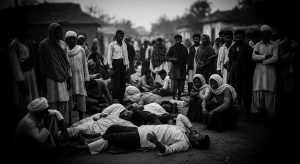On 27 May 2014, Farzana Iqbal, a 30-years-old woman who was pregnant with the husband of her choice, was waiting outside the Lahore High Court when her father, brother and ex-fiance appeared right front of the court’s gate.
Construing the aggressive mob – which includes her father and brother – as life-threatening, Farzana tried to enter the courtroom and save her life. But a pregnant woman’s agony couldn’t placate the tenacity of the men who had undertaken the mission to restore their lost ‘honour’. Farzana was brutally murdered by being repeatedly hit by bricks and sticks. Sighting the bleeding in abundance brought back the sense of honour, not to mention the unborn baby inside her womb that perhaps was never part of God’s plan.
The ‘intangible’ honour is supposedly restored by a murder. However, it staggers the mind as to how and when the societies during the course of their evolution develop such concepts and practices and under which conditions honour culture is flourished.
Is it a purely hate-driven and independent prejudicious act or is rather determined and generated by certain socio-economic and tangible conditions?
Historians and scholars have noted that intangible concepts and ideas are not independent and are not generated out of thin air. Dialectical historicism suggests that material and socio-economic conditions shape and determine the ideas, concepts and institutions of human
societies. Similarly, honour culture is also generated in certain conditions.
It is widely argued that violence against women is deeply rooted in established misogynist and patriarchal norms and mindset of the social fabric, but when asked about as to what leads men to commit violence against women, it sounds too illogical and sexist to the ears when the violence against women is attributed to ‘innate misogyny’ of men.

This approach to the social concepts is rather driven by emotions and precludes any pragmatic and scientific understanding of the origins of it.
For example, historians now believe that gender inequality and patriarchy flourished when human societies, from hunter and gatherer, shifted to the agricultural societies. The reason being the dramatic changes in the workforce as the heavy and rigorous agricultural duties required more masculine power and less feminine skills. As the societies grew and developed, the gender standards and definitions became more strict and tough.
Through the course of evolution, different tangible conditions produced different ideas and prejudices in human societies, while some conditions favoured violence against women, others proved to be inimical to feelings and prejudices that are now categorised as patriarchal and misogyny. In the end, it was social, economic, and institutional factors that determined and preceded the ‘misogyny’ and patriarchy.
Studies of human societies and cultures is complex and it should be kept in mind that what appears to be the problem is actually a by-product of what preceded it, in this case, it is the condition under which course or trajectory of human evolution took place.
Fresh research into the matter has also suggested that reliability of institutions and toughness of the environment are crucial conditions for the evolution of honour cultures. Moreover, the results show that honour cultures and aggressive cultures are mutually dependent in what resembles a predator-prey relationship described in the renowned Lotka-Volterra model.
Another theory suggests that selection and the affordability of the action also determine our choices.
For example, you are walking down the street and an aggressive person confronts you. You can take a number of different actions. You could use a rational strategy and fight back only if you believe you are stronger than the challenger but surrender if you believe you are weaker.
Contrary to this, the so-called “honour” strategy says you could always fight back when confronted, even if you perceive yourself as weaker. This is further refuted by the researches and surveys conducted to show how certain punishments and legal measures have served as effective deterrents against social ills.
It has been acknowledged, through scientific studies, that it is rationality and concrete conditions that determine what we do. If society and its institutions are not strong enough and succumb to the pressure, loud and aggressive mobs will get off scot-free and if institutions or “external conditions” are unfavourable, there will be no option to resort to and seek credence for your so-called honour.
There are countless permutations and academics and scholars have been engaged in this debate for decades and the recent studies in gender issues and history of sexuality is just decades old overdid with some ‘feminist’ interpretations, devoid of pragmatism. This piece is an attempt to initiate a healthy discussion about the complex structures of human societies and evolution, which have long been deprived of scientific research or any attention at all.
Feminism, on the other hand, has put its focus solely on the outcome of violence against women and the manifestation of institutional weaknesses through human expression, while it fails or deliberately overlooks the roots of this problem. It would pronounce it to be misogyny but fails to answer it rationally as to what is misogyny and what generates it.













